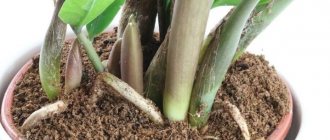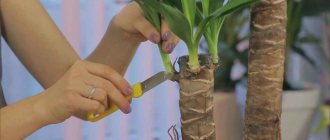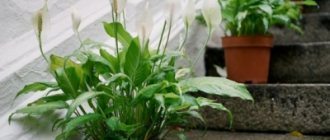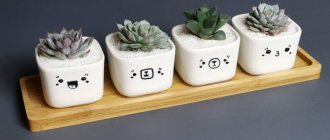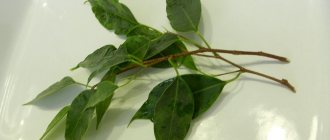Category: Care Published 08/19/2018 · Comments: · Reading time: 6 min · Views: 6,714
The main difficulties with transplanting indoor palm trees are related to its large size and the composition of the substrate. If you can still cope with the large dimensions of the transplanted plant by inviting help, then with the soil mixture the situation is much more troublesome.
The assortment of flower shops is designed for young seedlings and seedlings, but, unfortunately, the components of soil mixtures for mature plants cannot be found on their shelves. How to replant a palm tree at home correctly, in compliance with all the requirements imposed by the plant and necessary for its normal development?
It is important for novice flower growers who decide to have a large plant in their apartment to know all the subtleties of replanting: • how to choose the right pot for different age plants; • what kind of soil is needed for young and more mature palm trees; • how to step by step carry out all the steps to move a plant from one container to another; • what to do if unexpected problems arise?
Growing
This indoor plant can not only be purchased in the store, as it is easy to grow yourself. It is necessary to take a ripe fruit seed and place it vertically in a medium-sized ceramic pot.
The soil is wet sand and sawdust. After 4 months, a sprout appears. After this, the question arises: how to transplant a palm tree? It’s easy to do this step by step at home.
Why does the plant dry out after transplanting?
The most common question that arises among novice plant growers is: why does the palm tree dry out after replanting? There are several explanations for this.
If the recommendations were not followed during the process of transshipment of the root system, the palm tree may die.
The reasons for this phenomenon:
Compliance with all the rules will give a beautiful result in the form of a well-groomed and healthy palm tree, as shown in the photo.
Useful video
Regularly replanting palm trees at home is a necessary component of proper crop care. In fresh soil and a pot, the plant will retain its decorative properties and health, and will actively resist pests and diseases.
In order for the tree to adapt as quickly as possible after transshipment, manipulations must be carried out carefully, without damaging the root system.
What is necessary?
First you need to prepare the soil, which consists of:
- From turf land.
- Leafy soil.
- Peat.
- Humus.
- Yellow sand.
The components are mixed in a ratio of 2:2:4:1:2 with the addition of charcoal in small quantities. This composition ensures normal development of the plant.
Soil preparation
Exot prefers nutritious soil composition. That is why the soil should be prepared “fattier” than the previous composition. Naturally, you can purchase ready-made soil at a specialty store. But professionals recommend preparing the soil yourself:
- 2 parts of turf soil, always airy and light.
- 2 parts leaf soil with humus added.
- 1 part peat.
- 1 part compost (can be replaced with humus).
- 1 part river sand.
Also, before you start replanting, you should add wood ash to the soil. All components are mixed well.
Important! The soil mixture prepared with your own hands needs to be disinfected.
There are different ways to disinfect soil:
- The slightly moistened soil is placed in a microwave oven and fried for 2 minutes or placed in a regular oven for 10 minutes.
- The soil is placed in a container and steamed in a water bath.
- Spill with a solution of potassium permanganate (1 g per 1 liter of water).
Choosing a pot
In order for the palm tree to grow well, you need to choose a suitable container. It should not only be beautiful, but also meet several indicators:
- Choose a container 2-3 cm larger in diameter than the previous one to accommodate the overgrown roots.
- There should be holes at the bottom.
- You should not purchase a pot that is oversized, as there is a risk of water retention and death of the flower.
- For an adult flower, a glass-shaped container would be an excellent choice. The material of the pot does not affect the growth of the palm tree, so it can be anything.
Why shouldn't you forget about transplantation?
For normal development, each plant needs adequate nutrition. The root system of a domestic palm tree is limited to the space of the pot, the soil in which becomes depleted over time.
Although additional feedings replenish the flower’s need for macro- and microelements, they cannot fully support normal growth.
Transplants come to the rescue, which are important to carry out on a regular basis. As a result, fresh soil ensures normal absorption of nutrients by the roots, which has a positive effect on the immunity and appearance of the crop.
Newly purchased palm trees growing in shipping pots deserve special attention. After entering home conditions, they must be replanted, replacing the sterile peat substrate with nutritious soil.
This not only shortens the period of “acclimatization” of the plant to the new environment, but also prevents its rapid death caused by soil soaking.
Frequency and recommended timing
There is no point in delaying the transplantation of a purchased palm tree - this will not improve its health, and will also double the time it takes to get used to the conditions of the apartment. It is better to carry out the procedure immediately, completely removing the peat substrate from the root shoots.
As for domestic palm trees, the frequency of replanting depends on the age of the plant itself:
- Young specimens are placed in larger pots annually;
- Trees up to 6 years old need to be transshipped every 2-3 years;
- For mature large palm trees, the handling of which is difficult, the top layer of the substrate is replaced, supplemented with intensive feeding.
Transfer
Palm trees have a complex root system. They are sensitive. Typically, the transshipment method is used for transplantation. The plant must be handled with care. Care must be taken not to damage healthy tissue.
When performing this procedure, you must be careful not to tear off the remains of the family from the roots. A sprout appears, like a small green stick. This confirms that the plant is developing correctly.
How to replant a palm tree at home so that it develops correctly? To do this, you need to choose a spacious pot, the diameter of which should be 8-10 cm. It should be placed in a lighted place. If sunlight comes in, this will allow the palm tree to grow and strengthen.
When replanting, the root system must be washed every year. If necessary, some roots can be cut off so that this does not harm the plant. It also improves the supply of nutrients to the leaves and trunk. After cutting the roots, they are treated with disinfectant components - charcoal or ash, epin. After drying, the palm tree must be transplanted into a larger pot.
Expanded clay should be placed at the bottom of the container to prevent the soil from becoming too wet. Then the palm tree needs to be watered. If it is not possible to water it every day, then this should be done every 2 days, taking into account the condition of the soil and temperature. During the day, the plant should be sprayed, creating the effect of thick rain.
The influence of moon phases on plants
- The new moon is the worst time for gardening work. Do not plant or replant anything. This unfavorable period lasts three days, the day before the new moon, the new moon and the day after.
- Growing Moon - The Moon grows itself and pulls up the energy and juices of plants. This is the best time to work with plants whose fruits ripen above the ground (greens, herbs, fruits, vegetables, flowers). You can plant, replant, graft, and so on.
- Full moon - during this period it is also not recommended for planting and replanting plants, but it lasts one day. You can do weeding, fertilizing, and treating the garden from pests.
- Waning Moon - juices and energy are directed down to the roots, so try to work with root vegetables, bulbous ones.
See also: Planting catharanthus according to the lunar calendar in 2021: favorable days
What does “first quarter” and “third quarter” mean in the Lunar calendar
After the new moon, the Moon begins to grow, its crescent appears in the sky and gradually increases in size. At some point in the lunar month, it turns out that exactly half of the lunar disk appears illuminated to us, and the other half is not visible. This phase of the synodic lunar month is called the first quarter.
In the third quarter or last quarter, we again see exactly half of the Moon, but this is already a waning, aging Moon. It's like a mirror image of the first quarter.
Is it possible to visually determine what phase the Moon is in, whether it is waxing or waning?
Yes, you can. It's very easy to do.
Look at the Moon and mentally place a pencil near its “horns”. If you get the correct letter “P”, it means the Moon is waxing, but if you get “P” on the contrary, something similar to the letter “U”, it means waning.
There are some more rules and recommendations that should be followed:
- It is best to plant plants at dawn or before lunch.
- When the Moon is waxing, use mineral supplements.
- When decreasing - organic.
What plants can be planted on the waxing Moon?
The waxing moon is a favorable phase for the growth and reproduction of plants, the period of their most intensive growth.
During the waxing Moon phase, it is favorable to plant ground fruits, flowers, as well as medicinal and lawn herbs, fast-growing shrubs, vegetables, leaf crops, including roses.
During this period, it is good to sow the lawn and replant indoor flowers, plant garden flowers, and harvest.
What plants can be planted on the waning moon
During the waning Moon phase, it is recommended to care for plants, fight pests, sow and plant plants whose fruits ripen underground, various fruit bushes and trees.
Good for the waning moon:
- Plant trees and seedlings
- Cuttings from plants
- Divide perennials
- Trim and shape trees and shrubs
- Collect seeds
What can be planted during the new and full moon?
These days the earth freezes and does not give its energy to plants, so it is better not to plant anything these days.
On full moon days it is good to collect fruits (except for root vegetables)
You can care for plants during a Lunar Eclipse
On the days of lunar eclipses, it is better NOT to carry out any work with plants!!!
Replanting uncommon palm species
Proper replanting keeps the plant in excellent shape. This is necessary for its normal development. How to replant a palm tree at home? You should select loose soil without lumps and hard layers. It must contain nutritional components for normal plant development. It is advisable to replant in the spring, when the palm tree has rested from winter.
How to replant a date palm at home? This procedure is performed according to the standard method as for an ordinary indoor plant. It is important to choose the right soil, maintain it, and fertilize it.
After 5 years, there is no need to replant the plant every year, so the procedure is performed after a few years. Before purchasing a pot, you need to inspect the root system of the palm tree to ensure the container fits. It should be the right size. It should be taken into account that the roots grow in breadth and depth. If you have any doubts about how to replant a palm tree at home, you should ask a specialist to do it.
Soil for palm trees: main components
Most palm trees prefer a nutritious compost-based soil mixture. For different species, the composition of the substrate will be different, because their need for nutrients is different. The soil mixture for young and adult specimens is also distinctive. The younger the palm tree is, the lighter the soil it needs.
The main components used in the preparation of the substrate for growing palm trees: • turf soil - harvested from cereal-clover meadows and pastures in July; • leaf soil – fallen leaves or soil under a layer of fallen leaves in a forest or garden that has rotted for 2–3 years; • humus soil, or greenhouse soil - collected from rotted manure used in greenhouses; • peat soil – collected from lowland peat bogs; • moss – stored in deciduous forests or mossy swamps.
A light substrate for sowing palm seeds and growing seedlings is made up of 3 parts humus, leaf or peat grass, 1 part turf and 1 part coarse sand. Plants aged 2 to 5 years need medium-heavy palm soil with good water permeability, including 2 volumes of turf soil, 1 volume of sand and 2 volumes of leaf, humus or peat soil. Adult large plants over 6 years old need heavy humus soil, consisting of 3 parts of turf soil and 1 part each of sand and humus or leaf soil.
It happens that the age of the palm tree is unknown to the owner - plants are often disposed of by those who cannot grow specimens that have become too large in their apartment. In this case, you should use a universal recipe for a nutritious soil mixture that will suit most palm trees:
- light clay-turf soil – 2 volumes;
- bottom peat – 1 volume;
- humus-leaf soil – 2 volumes;
- rotted manure – 1 volume;
- coarse river sand – 1 volume;
- some charcoal.
On poor soils composed of insufficient nutritional components, palm trees develop poorly.
Care
It is important to know not only how to properly transplant a palm tree at home, but also how to care for it. Due to the drying out of the plant, many pests that were in the soil may appear. You can prevent trouble by disinfecting the soil, which is done before replanting.
Experts advise heating the soil mixture (1 kg) at high temperature in the microwave. This will kill all unnecessary microorganisms. Palm trees are afraid of drafts, so they need to be placed in a safe place. If the flowerpot does not have good drainage, there will be stagnation of water and rotting of the root system. Yellowing of the leaves indicates the need for replanting and feeding.
To prevent the death of plants, this procedure must be performed within the near future. Drying of the ends of the leaves indicates a lack of moist air. Spraying the plants with warm water from a spray bottle will help eliminate this problem. You can wipe the leaves with a cloth. There must be natural conditions for palm trees, and then they will develop perfectly.
Interested in how to replant a dracaena palm tree at home? This procedure is standard. It is important to follow the same principles as for a regular indoor palm tree. Plants can get sick, so if signs of deterioration are found, you need to show it to a specialist. You should not delay this, as some diseases lead to the death of palm trees.
Plants are often affected by viruses that are common in the room. To prevent this, you need to inspect the leaves every day, and when replanting, the root system. How to replant a yucca palm at home? The procedure is carried out according to the same specifics as with a regular plant.
For irrigation, you should choose purified water. Its temperature should be the same as that of the air. If tap water is used, it must be left to stand for 24 hours. All types of palm trees have different watering frequency. Water should be used so much that the excess flows out through the drainage. If there is insufficient moisture in the ground, salts accumulate and therefore the plant suffers.
Choosing ready-made soil for palm trees
Many manufacturers offer a ready-made soil mixture, but experienced gardeners use it as a base, adding various components to improve its composition. In terms of their structure, ready-made soil mixtures for palm trees are light (in most cases), they are suitable for growing young specimens.
When choosing a ready-made soil, you need to find out what the composition and acidity level should be, as well as the shelf life. Although many ready-made soil mixtures have an unlimited shelf life.
The soil for palm trees should be loose, air- and moisture-permeable, with a sufficient amount of nutrients and a pH of 6.3-6.5. Palm trees love soil with a neutral or slightly acidic reaction.
Ready-to-use special nutrient soil for all types of palm trees, usually consists of:
- highland and lowland peat;
- sand;
- dolomite flour;
- expanded clay drainage;
- mineral fertilizers and vermicompost.
A soil mixture specially designed for palm trees promotes normal plant growth and development.
Reproduction
Propagation by seeds is considered a complex process. With this method there is a small chance of germination. Purchased seeds may lose their properties and not germinate. Before planting, you need to saw off the hard shell and soak it in warm water for 4 days. When a sprout appears, it is transplanted into a small pot so that the plant is protected from root growth.
Propagation by plant parts may not occur with all palm trees. With careful care and constant watering, growth can be controlled. The palm tree will delight its owners and also purify the air in the room.
Irrigation technology and fertilization
The domestic palm tree should be watered very often, preferably 3-4 times a week, so that its growing conditions best correspond to the weather conditions of the tropics. The soil should not dry out; the resulting crust will have a bad effect on the air exchange of the roots. To retain moisture in the soil as much as possible and not constantly water the plant, you can make mulch from sawdust or humus. Then the frequency of watering will be 1-2 times a week.
The amount of water in summer should be very large, that is, we make a swamp out of the soil. In winter, you can reduce this intensity and simply water it like regular flowers a couple of times a week to maintain moisture. We must not forget about fertilizers, since a large vegetative mass sucks all the useful substances from the soil. Thus, in 1-2 weeks nothing remains in the ground.
Foliar feeding, as when growing aloe, is not recommended, because the leaves are much more tender. Any chemical can burn them at the slightest overdose. It is better to use a proven method - root feeding. It is necessary to apply superphosphate 2 times a month, the dose is 5-10 grams per 5 liter pot or per plant 80-120 centimeters. The soil must initially be saturated with all the missing components, primarily with organic matter. To do this, place some peat, manure, and organic mixtures on the bottom of the pot. Make sure that the roots do not immediately reach the fertilizer when planting - they may burn.
Domestic palm trees respond well to fertilizing; the leaves begin to turn green and rise up within a couple of days.
Disinfection of soil mixture
To disinfect the soil mixture during plant transplantation, it is moistened and heated in an oven or steam. You can fill it with potassium permanganate.
The disinfected soil mixture is poured onto the drainage layer. After the root ball has been cleared of peat, its rotten roots are cut off. Damage is treated with ground charcoal, aluminum powder or ash.
It is advisable, before planting a palm tree, to treat the roots with clay mash, which helps to lighten damaged roots when replanting and compacting the soil in a flowerpot.
The roots are straightened, placed correctly in the pot and, carefully compacting, the soil mixture is poured out. It is necessary to leave 3–5 cm from the surface of the soil mixture to the edge of the flowerpot so that you can water the plant.
It is not recommended to replant a large palm tree and deepen it too much in this process in order to avoid rotting.
General characteristics of soil for palm trees
If we talk about the characteristic features of the soil mixture, then when choosing a substrate it is worth paying attention to a number of aspects that are considered key:
- The soil should allow air to pass through and be loose.
- Acidity should be low, within 6.5.
What kind of soil and pot do you need for a palm tree?
Even a young palm tree needs nitrogen, but as a rule, substrates sold in flower shops contain this element in sufficient quantities. If necessary, you can feed the palm tree to speed up its growth. But the main thing here is not to overdo it.
The palm tree, as a plant that prefers warmth and sun, does not tolerate stagnant moisture; for this reason, it is better for the gardener to take care of the drainage system in advance.
If the soil is loose, allows moisture and air to pass through well, is low in acidity, and contains the necessary nutrients, then it can be safely used for planting.
Types of substrates
According to the composition indicated on the packaging, all plant substrates seem to be the same: peat, sand, dolomite flour... However, in consistency, structure and even color they turn out to be different from each other! It depends on the predominance of certain components. How to make soil at home.
Thus, even the finished substrate can be adjusted, brought to the shape you need, by adding individual components. For example, turf soil will add nutritional value to the soil, compost will saturate it with organic microelements, sphagnum and lowland peat will add moisture capacity, sand will lighten heavy soil, vermiculite and perlite will add “air,” and bark and charcoal will make it more loose. Experiment taking into account the needs of your pets!
Soil for cacti and succulents
Usually the basis for it is a mixture of high and middle peat, due to this it has a brown color and a loose structure. A mandatory component is sand. Although succulents prefer poor soils, the composition may contain sapropel, which adds hygroscopicity.
- Tip: Sometimes store-bought soil for succulents is too fibrous, and water just passes right through without being retained. In this case, it is advisable to add one part of nutritious peat, garden soil, or recycled leaf compost.
Soil for palm trees
Palm trees are slightly more moisture-loving than succulents; the soil for them is made on the basis of middle peat, vermicompost, with the addition of sapropel, sand and vermiculite.
- Advice: palm trees still do not like stagnant moisture, so the soil should not be heavy and clogged. Coarse-grained river sand will help lighten its structure (the sand sold in aquarium stores is perfect).
✿
